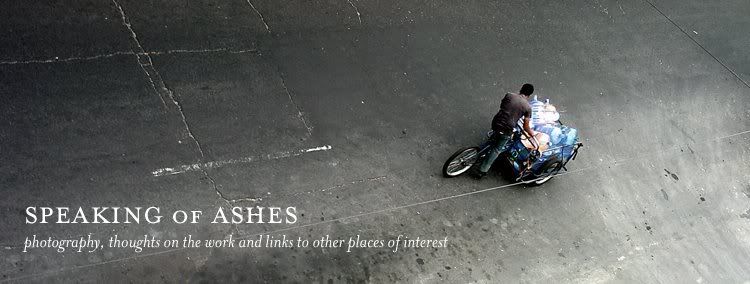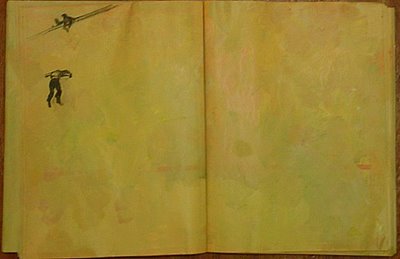 I think my first post on this subject was well short of the mark on a number of issues and so I will try again. By returning to Berman quoting Bateson.
I think my first post on this subject was well short of the mark on a number of issues and so I will try again. By returning to Berman quoting Bateson.
He was glad to see her [writes Bateson] and impulsively put his arm around her shoulders, whereupon she stiffened. He withdrew his arm and she asked, "Don't you love me any more?" He then blushed, and she said, "Dear, you must not be so easily embarassed and afraid of your feelings." The patient was able to stay with her only a few minutes more and following her departure he assaulted an orderly and was put in the tubs.
It is the idea of the mother stiffening that I still find so outrageous. The real thing that bothers, is that it is not necessarily the son's fault that he is schizophrenic. Throughout his life his mother has been sending mixed signals. "On the one hand, love me, but not too much."
I knew an artist who was channeled into drawing pictures of the most embarassing and intimate details of her childhood, excruciating moments of deeply personal and touching clarity. These were all always rendered in a faux naif style that kept them trapped in a sort of a gallery-chic motif. The idea of presenting any of the content of childhood, any moment of pain or triumph had been completely and utterly expelled from the equation. These drawings were going to be art because of the ironic distance between the subject and the artist. The artist was stiffened to the idea of her own childhood and presented this irony as if it were art.
Whenever there is "art," it seems now that stiffened distance is absolutely necessary. And while I agree wholeheartedly with springs and wells' proffered solution here, it still surprises me that art dealers do not get a grasp on this. I've bemoaned their position in other places, but I come to the conclusion that many art dealers, like many institutionalized MFA faculty members fear grabbing onto any organized school of thought and it's self-reflecting style (however loosely defined) and pushing like hell to get it out there. And more importantly, pushing like hell to collectively understand what it is, and what are the implications.
Winkelman mentioned this the other day.
I know anyone stepping forward with a manifesto would likely be mocked right out of Chelsea, but there do seem to be many more art collectives making waves than a decade ago. Can an "ism" be far behind?
Well, what is holding these art collectives together ? I think one could make a strong argument that in many cases collectives act in a limbo area between self-preservation and against a self-inflicted self-fulfilling gentrification. Like colonists with pox-laden blankets, they go into the "real neighborhoods" to escape gentrification. And again, we stiffen at the fruit of our labor.
We don't want gentrification, and yet anyone who lives out in the frontiers of Brooklyn longs for a decent supermarket because the bodegas canned goods have expired sell-by dates and dust on the faded cereal boxes. And yet we are proud for making our stand and only bitch privately.
The schizophrenia of the $90,000 annual MFA program (mentioned in a nice rant and comments here) and the gentrification that follows is the same schizophrenia of the $90,000 MBA program - the classic "who you know, not what you know" dilemma. Business people (including art dealers) love to talk about altruism, but haven't got time to understand why people become artists anymore than do MFA faculty members. This is the same schizophrenia of billion dollar corporations dumping money into the American Heritage Foundation, while demanding more and more government contracts - that's a Soviet level of corruption in many senses of both words. They stiffen when they hear us speak of "Love of Country" because they know we are a threat to them, just as the institutionalized (tenured) artist stiffens when she remembers why she wanted to be an artist (ie; "Love of Art").
She stiffenes when there is personal content and tries to reframe this content in terms of "art," in terms that the in-humane others she perceives (and thus creates) can digest. Thus the light falling on the naked body reaches only near the body, for the body, being personal, being human and touchable, vulnerable, must be re-cast to fulfill the role of the part-human, that is, she who should never dream of becoming fully him or herself. The all consuming -ism we find over and over again unworkable remains simply captialism. And the -isms arrayed against it are not so very new.
 well things are looking up. I will be working now at getting that side bar loaded back up with the correct links for everyone else's blogs. Shouldn't take long. I also finished reading Tolstoy's Resurrection, which was incredible, succinct, powerful. Summer is drawing to a close and I have a few more guests to entertain so that will probly again keep me from blogging as much as maybe I'd like, but we'll see. Autumn is my favorite season. Today I walked through the park after one of our daily downpours. Should be a good season.
well things are looking up. I will be working now at getting that side bar loaded back up with the correct links for everyone else's blogs. Shouldn't take long. I also finished reading Tolstoy's Resurrection, which was incredible, succinct, powerful. Summer is drawing to a close and I have a few more guests to entertain so that will probly again keep me from blogging as much as maybe I'd like, but we'll see. Autumn is my favorite season. Today I walked through the park after one of our daily downpours. Should be a good season.












